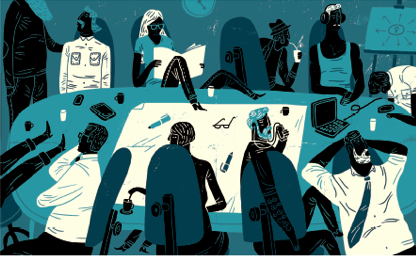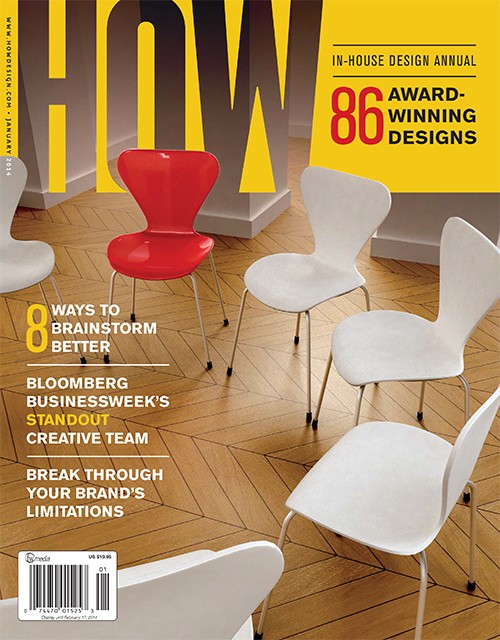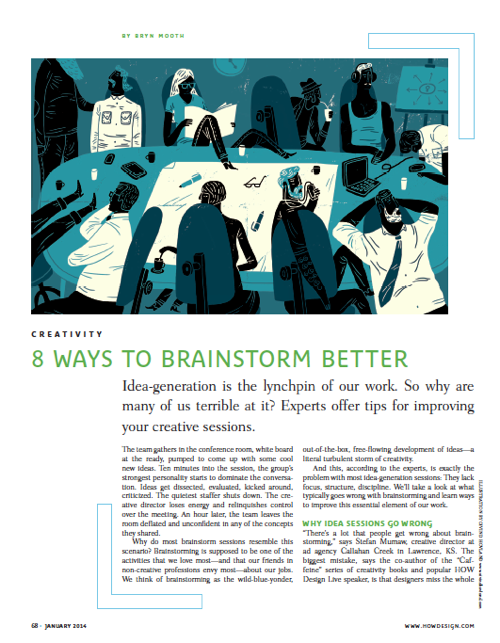If there’s one thing I miss most about working in an office with a team, it’s the buzz of kicking ideas around with a few colleagues. Those spontaneous hallway conversations: “What would happen if we …?” “What if …?”
For those of us creative professionals who work solo, idea-generation can be a real challenge. Alone at our computers and faced with a deadline, it’s hard to find inspiration to come up with something fresh. Brainstorming by yourself is like talking into a paper bag: you don’t even get an echo.
I recently wrote a Creativity column for HOW (that ended up as a cover story—yay!) that offered 8 better strategies for brainstorming. The story focused on group ideation—it’s targeted at design agencies and in-house creative departments—but there are a few lessons from the experts I spoke with that apply to those of us who create on our own.
A few tips for better by-yourself-brainstorming:
Gather your inputs. As I wrote in a blog post here last fall on the seemingly random nature of idea-generation and how to spark new ideas—creativity doesn’t happen in a vacuum. You need to feed information and inspiration into your creative mind and let that stew for awhile before ideas can germinate. Preliminary research plays a big role in defining the problem and the parameters around it. Bruce Grover, managing director and strategy lead for Suka Creative, a 10-person strategy/content/design agency in New York City, told me for the HOW story that his team goes through a research and discovery phase—the results of which they verify with the client to be sure they’re on track—before they assemble to brainstorm.
Create the right space. Get away from your computer—from your office, if you can. Go to a library, a museum, a restaurant. Change your venue, give yourself different distractions, open your eyes to unfamiliar things. Grab your favorite notebook and pen, and doodle or write whatever comes to mind. Don’t filter, just go.
Set the right expectations. Don’t assume that brainstorming is about finding a definitive answer. “[Creatives] think that the general goal is to leave with a solution, one that’s thought through and vetted and right,” Stefan Mumaw told me for the story. “That’s not the case. Brainstorming isn’t to solve the problem. It’s simply to offer possibility.”
Turn off the critic. Setting the wrong goal for a brainstorm session leads to another common problem: Evaluating ideas as they emerge. When you start to critique each idea as you jot it down, you shut off the flow. “The original definition of brainstorming, where you take everyone, throw them in a room and they’re all shouting over each other, has two problems,” according to David Sherwin, author of “Creative Workshop” and “Success By Design,” and interaction design director with frog design’s San Francisco studio. “One, when you come up with ideas as a group, people immediately enter into discussion instead of dialog—defending, steering, blending open-ended idea-generation with thinly veiled critique.”
He also shared with me another common problem: “You don’t often have any idea of how to focus your attention.” While many brainstorm sessions are free-for-alls, Sherwin advocates for structure and parameters. “Cleverly considered constraints can yield more far-out ideas than free-form brainstorming,” he said. “You have a real target to shoot for.” The same goes for solo brainstorming: Ignore the critic until you have a bunch of ideas. Evaluation is for winnowing the list of ideas and choosing the most viable direction.
Check out the January issue of HOW magazine by clicking on the image below.
To read the full Creativity column on 8 Ways to Brainstorm Better, click the image below to view a PDF.


